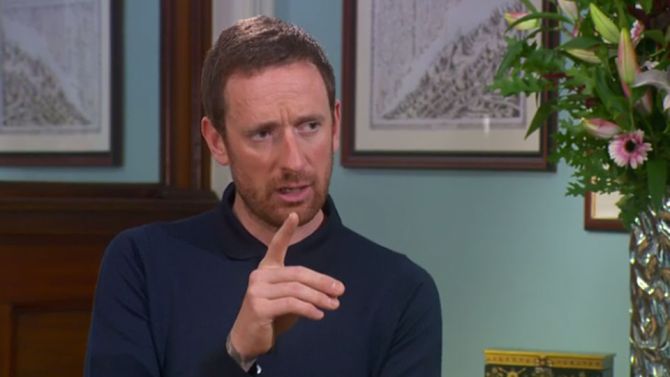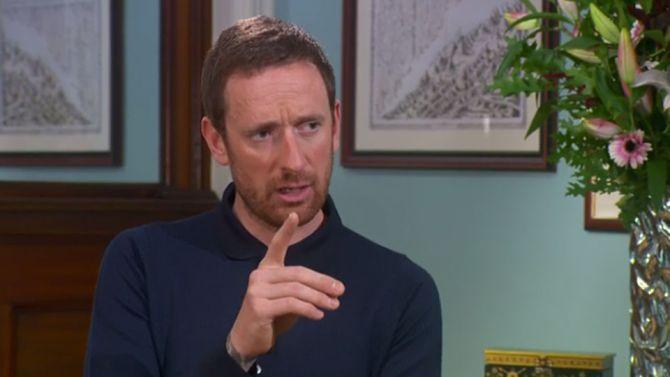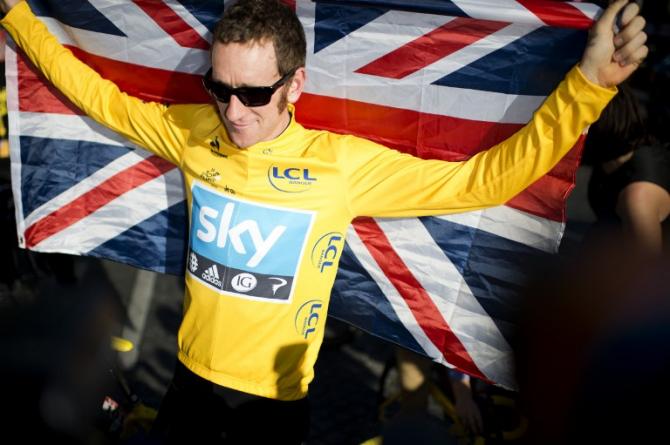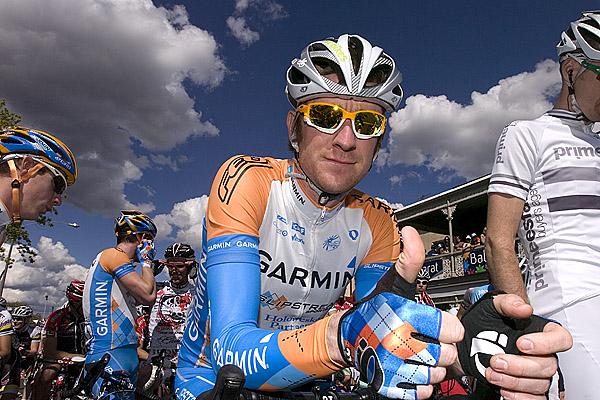Bradley Wiggins explains TUE use, asthma and allergies
2012 Tour de France winner explains his controversial TUE use to the Guardian

In an extensive interview with the Guardian, Bradley Wiggins has opened up properly for the first time about his controversial use of TUEs during his cycling career, his long standing allergies and asthma, his relationship with former Team Sky doctors Geert Leinders and Richard Freeman, and the ethical boundaries that his TUE use have thrown up.
Wiggins spokesperson on WADA leak: 'There's nothing new here'
UCI defends TUE use after Russians hack Wiggins, Froome medical records
Wiggins: Leinders had no part in TUE applications
Millar says Wiggins' TUE drugs should be banned
Wiggins to appear on British television to explain TUE controversy
Wiggins' TUE under scrutiny before Sunday morning interview
Wiggins says he didn't take triamcinolone to gain an unfair advantage
Tom Dumoulin says Wiggins' TUE case stinks
Bardet 'amazed' by Wiggins' TUEs ahead of Grand Tours
Bradley Wiggins, Team Sky and the TUE process - Podcast
WADA details response to Fancy Bears' hacking
Wiggins and Team Sky under fresh scrutiny over medical package delivery
Tiernan-Locke points finger at former Team Sky doctor over Tramadol claims
UK Anti-Doping 'swoop' into British Cycling
No rules broken and no action to follow in Wiggins TUE case, says Cookson
Cope: I don't know what was in the package for Team Sky
British Cycling physio faces questions over Team Sky's Dauphine medical package
Bradley Wiggins pulls out of Abu Dhabi Tour
UKAD pushing for blanket ban on drug used by Wiggins
Bradley Wiggins blasted by Kittel and Greipel over TUE
Wiggins missed whereabouts test three months before Rio Olympic Games
Wiggins, who won the Tour de France in 2012, hit the headlines a fortnight ago when the hackers calling themselves Fancy Bears leaked Wiggins’ TUE history. In total six TUEs were issued during Wiggins’ road racing career, however the three intramauscular injections of Triamcinolone acetonide raised eyebrows, with each usage applied before major Grand Tours, one of which - the Tour de France in 2012 – Wiggins won.
Although Wiggins and Team Sky never broke any rules with their application and use of the substance, it raised eyebrows with several respected doctors questioning the timing and nature of the TUE use.
In the aftermath of the revelations, Wiggins appeared on a BBC television show but that also created more questions than answers.
However in an exclusive interview with William Fotheringham, Wiggins has talked about his long-standing allergies, and what led him to apply and take several TUEs.
Bradley Wiggins' TUE use
• June 13, 2008: Salbutamol (200ug dosage, inhalation as needed for 12-months)
• December 12, 2008: Salbutamol (250ug dosage, inhalation as needed for 12-months)
• December 16, 2008: Salbutamol (2 puffs dosage, 2 times per day for 12-months), Formoterol (2 puffs dosage, 2 times per day for 12-months), Budesonide (2 inhalations dosage, 2 times per day for 12-months
• June 29, 2011: Triamcinolone acetonide (40mg intramauscular dosage, one time injection)
• June 26, 2012: Triamcinolone acetonide (40mg intramauscular dosage, one time injection)
• April 22, 2013: Triamcinolone acetonide (40mg intramauscular dosage, one time injection)
Ethics versus legality
While Team Sky and Wiggins broke no sporting rules under the WADA code with their use of the TUE system, their conduct did lead to several questions – most importantly if Wiggins was in so much need of a TUE on the eve of such major races, then should he have competed at all?
Get The Leadout Newsletter
The latest race content, interviews, features, reviews and expert buying guides, direct to your inbox!
Wiggins, who detailed his long-standing medical conditions to Fotheringham, explained that with context his need and use of TUEs could be explained. When asked if he understood why some had questions over the ethical judgment, Wiggins said:
“Without all the context of someone’s history then I could see that on paper maybe, especially the way some of it has been reported. It’s been very sensationalised in parts and very personal in other parts. Straight off, the way cycling is today, yes, yes. Because it doesn’t take much in cycling now because of what’s gone before. So I understand that.”
Read the full Guardian transcript.

My Time - updated
Wiggins’ TUE use for allergies also highlighted an inconsistency from his 2012 autobiography, My Time, in which he not only failed to mention his TUEs but also stated that he had “never had an injection, apart from I've had my vaccinations, and on occasion I've been put on a drip, when I've come down with diarrhoea or something or have been severely dehydrated."
Fotheringham was the ghost writer for the book which came out after Wiggins’ Tour win. The question as to why his TUEs were not mentioned in the book, was asked:
“I didn’t mention it in the book. I’d come off a season of … I’d won everything that year. When I was writing the book I wasn’t sat there thinking, 'I’d better bring my allergies up'. I was flying on cloud nine after dominating the sport all year. It wasn’t something that I brought to mind.
“Like I said, I’ve lived with this. All the doctors over the years I’ve been with in various teams will verify that I was always complaining of allergies. It will be in my medical records, the things they gave to me.
"The 2003 Giro was the first time I really struggled with it, the first time I’d gone to a three-week stage race and noticed it, a noticeable difference to performance. More than that, when I had a severe attack, the day after I was wiped out [Wiggins was eliminated from the 2003 Giro after the 18th stage where he was outside the time limit]."
Read the full Guardian transcript.

The timeline
During the interview, Wiggins explained that while he had suffered from an allergy to pollen for some time, it wasn’t until the 2003 Giro d’Italia, his first ever Grand Tour, that he first felt it had impacted his ability to race. Wiggins was forced to leave the race following stage 18 after missing the time cut.
“When I had a severe attack, the day after I was wiped out,” he said before going into the details of the attack. “[It is] uncontrollable sneezing, runny nose, watery eyes, the urge to rub my eyes constantly, and in doing that the eyes becoming bloodshot … extreme. My breathing became restricted, like breathing through a straw at times.”
After the incident, Wiggins went to see British Cycling Dr Roger Pelfreeman, who would remain his medical point of contact until the spring of 2010 when he left the organisation. Dr Richard Freeman would come on board to replace him, working at both British Cycling and Team Sky, which made its debut that season. Wiggins says that the decision to stick with Dr Palfreeman was one of continuity as he moved around teams. Under his advice, Wiggins went under a series of tests.
“The results… were sent to the UCI and he pushed hard with the French Federation – I was racing for a French team at that time – and the UCI. I’m not sure what it would have been called, but it was the equivalent of today’s TUE,” he explained. “Back then at a pro team it would be written in your health book, it would be for two inhalers, fluticasone and salbutamol – it was the red inhaler basically. It was all agreed, stamped off and sent to the French Federation.
“In 2004 I went through the same process again, but I needed authorisation to compete at the summer Olympics under IOC doping regulations. So I had to complete another series of lung function tests, at the Manchester velodrome conducted by Andrea Wooles, who was in charge of that.
“Again, I did the lung function tests, all was well, and I got authorisation from the IOC. From 2005 to 2008 those applications were renewed each January to cover me for the season.”
Wiggins received three TUEs during the 2008 season, one in June and two in December. All were for 12 months and included varying dosages for Salbutamol. The last of the three, issued on December 16, also included the corticosteroid Budesonide and the β2-agonist Formoterol, which are often used together to combat asthma. That would run until the end of 2009, but when Wiggins joined Team Sky in 2010, he didn’t apply for a TUE.
“It wasn’t suggested to me,” he explained. “Aside from complaining about the normal symptoms – 'I’m on Clarityn, can you give me some of that, have we got loads on the race when we go to the Giro or the Tour? Can we have the nasal spray that I’m on? Just checking the usual stuff, eye drops, red inhalers, blue salbutamol inhalers' – never at any point was it suggested that we go and see a specialist.”

Wiggins says that he continued using over the counter hayfever products but suffered was affected badly by his allergies. The following season, 2011, he avoided any symptoms until racing at the Bayern Rundfahrt at the end of May where he says he ‘had quite a vicious attack.’ It wasn’t until the Dauphine in June that he met with Dr Freeman, who suggested he see a specialist. Following a training camp and the British national championships, Wiggins went to see a specialist on June 28, four days before the start of that year’s Tour de France. The application would be granted, with the date of June 29.
“I saw the specialist, he did a full examination of me, blood tests, this that and the other, I went home, and he compiled his report for Richard Freeman,” Wiggins said. “That’s the report he made to Richard Freeman. Upon doing that, the medication he suggested in there would need an application for a TUE. I was still unaware at this stage of what was happening because it was the first time I’d seen a specialist. Richard called me and said: 'you’ve been granted authorisation for a TUE based on seeing Dr Hargreaves' and that was that. He showed me the TUE application; he showed me the TUE certificate, and it was administered.
In 2012, Wiggins did not suffer any symptoms until he returned to racing following a training camp in Tenerife.
“Then I came back end of May, started to get the onset of symptoms then, once I was back home, we live surrounded by fields and woods, flowers and things so straight away I’d come out of that bubble in Tenerife and was straight into the onset of symptoms. Started all the usual, Clarityn, this that and the other, went to the Dauphiné, symptoms carried on as per usual, won the Dauphiné.”
The second TUE for Triamcinolone acetonide, also known as Kenalog, was issued some time after the Dauphine, in the week leading up to the Tour de France. A third one was issued at the end of April the following season. That’s where the TUEs stop for Wiggins, who says that his early racing schedule meant that he avoided any serious symptoms in 2014, and his decision to move to the track later that season also played a major factor.
“[I] was training indoors most of the time. I wasn’t displaying the symptoms, or they weren’t problematic, it wasn’t a huge issue other than going out on the road around here using Clarityn, eyedrops. I was indoors, I wasn’t having problems with my breathing, I wasn’t complaining about it, I didn’t need to go and see a specialist or anything.
“It was the same in 2015. I knew I’d finish at Paris-Roubaix, I knew I’d go and do the Hour Record project, and 90% of that is going to be indoors... it wasn’t a problem.”